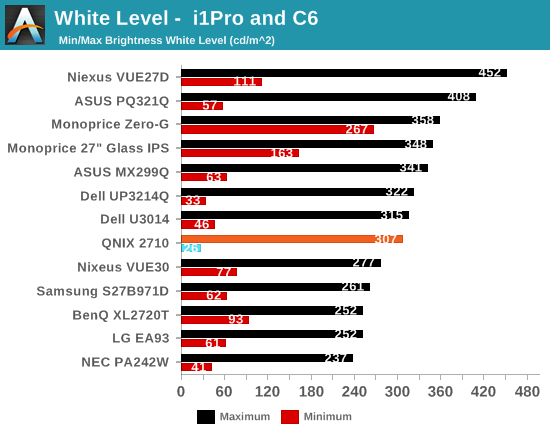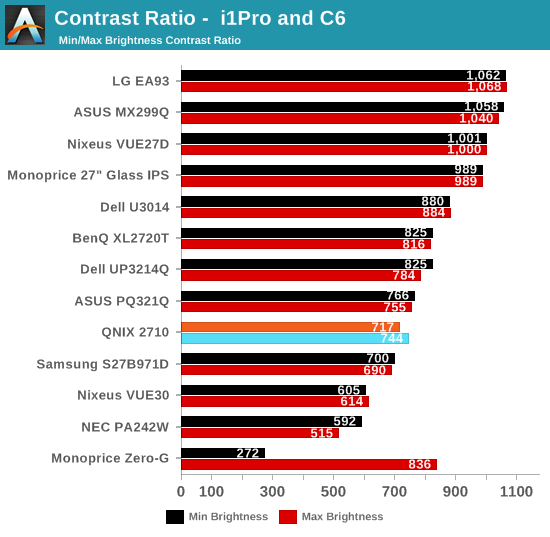QNIX QX2710 LED DPmulti True10 Review
by Chris Heinonen on April 11, 2014 6:00 AM ESTBrightness and Contrast
As I mentioned, I am not using the dynamic contrast feature for any of these measurements. Since it does not allow you to adjust the brightness when it is enabled, it will be far too bright for regular use and seems designed to mostly produce a number that looks good on spec sheets. In use it also takes nearly 3 seconds to respond to a change in average picture level, which most people will find too slow and annoying in actual use.
When the backlight is set to the maximum, a white field puts out 307 cd/m2 of light. Setting the backlight to minimum causes the white reading to fall down to 26 cd/m2. While the backlight setting is adjustable from 0-100, it is only adjustable in increments of 3, so it is really 0-33. These coarse adjustments cause issues later on as hitting 200 cd/m2 is a bit harder.

The black level with the backlight at maximum is a rather high 0.4122 cd/m2 and with it at minimum it is 0.0369 cd/m2. While the AUO panel used is AHVA, this is really more of an IPS type panel as opposed to being a VA type panel. AHVA (Advanced Hyper-Viewing Angle) is fundamentally different than VA (Vertical Alignment), and PVA/MVA panels would generally show much better black levels than this.

These combine to have mediocre contrast ratios of 717:1 and 744:1. Modern IPS panels are now doing over 1,000:1 and VA panels can be past 4,000:1. Since this is the first AHVA panel I’ve seen I’m not sure if this is an overall flaw with the AHVA technology or with the implementation in this monitor -- or perhaps a bit of both.

The QNIX is plenty bright and offers a nice lower level brightness setting as well. The rest of the brightness settings are too coarse to easily select a specific level, while the black level and contrast ratios suffer overall. In short, this isn't a professional grade display, but then the pricing and source should have already made that abundantly clear.










85 Comments
View All Comments
lazarpandar - Friday, April 11, 2014 - link
HD refers to 1280x720 so it logically follows that QHD refers to 2560x1440. Look at some laptop spec sheets, they all claim HD for 1366x768 and Full HD for 1920x1080. This review is not confusing in any way, it just sounds like you guys weren't very familiar with the terminology (which is admittedly kind of confusing).LordOfTheBoired - Sunday, April 13, 2014 - link
The terminology isn't confusing. It's stupid, and it always has been. The *GA line isn't any better(it's actually far worse, for various reasons).Specify resolution with a perfectly good X by Y spec, or don't bother at all. Leave the cute nicknames on the mass-marketing bullet lists where they belong.
WithoutWeakness - Friday, April 11, 2014 - link
HD = 1280x720FullHD (FHD) = 1920x1080
QuadHD (QHD) = 2560x1440
UltraHD (UHD, 4K) = 3840x2160
The confusion has come in when people have begin referring to 1920x1080 as "HD". By that definition, "QuadHD" then implies 4x1080p or 4K, which is incorrect. QuadHD has always been 2560x1440. So the confusion doesn't come from how the article is written - it comes from the incorrect definition of "HD" that has perpetuated over the last few years as new confusing acronyms are coined for higher-resolution displays.
phoenix_rizzen - Friday, April 11, 2014 - link
The confusion comes in when people refer to the vertical resolution for years and years (480p, 720p, 1080p) and then switch to using the horizontal resolution (2K, 4K), especially considering those monikers are off by several hunder to a thousand pixels.If everyone just keeps using the vertical resolution, then nobody gets confused.
480p
720p
1080p
1440p
2160p
Nice, neat, simple. Changing definitions in the middle is what's causing all the issues.
hennwei - Friday, April 11, 2014 - link
4K sounds way cooler though. and when it sounds cooler, it sells more. kaching!skifiddle - Sunday, April 13, 2014 - link
It is Cha-ching as in where it is made.Treckin - Thursday, April 24, 2014 - link
definitely cha ching as in the noise an antique cash register made...Laststop311 - Friday, April 11, 2014 - link
4k ultrade hd is sometimes referred to as QFHD quad full hdcoburn_c - Friday, April 11, 2014 - link
Panel grading refers to manufacturing defects, these ebay panels are usually B grade on a scale of A+,A,A-,B,C. Also WQHD is 1440p as the keywords, article, charts, and text state...blackoctagon - Thursday, May 1, 2014 - link
They're not only sold on eBay and the panel grade is actually A-